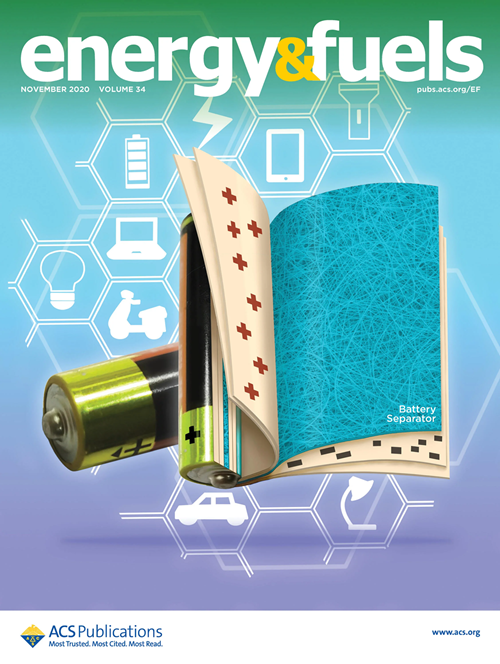嵌入双金属 MoCo 纳米片的 NiSe 纳米颗粒是一种有效的双功能水分离电催化剂
IF 5.3
3区 工程技术
Q2 ENERGY & FUELS
引用次数: 0
摘要
与贵金属催化剂相比,非贵金属因其成本效益高、供应充足而在绿色能源生产中显示出更优越的催化性能。在我们的研究中,我们采用水热法引入了一种新型异质结构,该异质结构由双金属 MoCo 纳米片作为基底,并锚定了 NiSe 纳米颗粒。我们采用不同的双金属 MoCo 和 NiSe 重量比(2:1、4:1 和 8:1)合成了不同成分的 MoCo-NiSe 异质结构,以确定实现最高效率的最佳配置。这些复合材料作为双功能电催化剂在碱性介质中进行了整体水分离(HER/OER)评估。值得注意的是,双金属钴和镍硒的混合物由于增加了表面积、孔隙率和降低了电荷转移阻力,表现出更强的电化学水分离能力。MoCo-NiSe(8:1)电催化剂的过电位明显较低,为 277 mV(@ j = 10 mA cm-2),OER 的塔菲尔斜率最低,为 139 mV dec-1。同样,MoCo-NiSe(2:1)也显示出与 HER 类似的动力学,具有更低的过电位(245 mV @ 10 mA cm-2)和 Tafel 值(50 mV dec-1)。此外,通过对 OER 和 HER 进行 24 小时的时变研究证明,这些电催化剂具有出色的稳定性,效率超过 90%。此外,整体水分离(OWS)的起始电位较低,为 1.66 V @ 10 mA cm-2,这表明了电催化过程中实现的效率和稳定性。所观察到的材料特性可归因于钴纳米片与纳米片中分散良好的镍硒纳米颗粒之间的协同效应。这项研究为创造新型纳米材料的能源转换应用提供了一种前景广阔的方法。本文章由计算机程序翻译,如有差异,请以英文原文为准。

NiSe Nanoparticles Embedded Bimetallic MoCo Nanoflakes as an Effective Bifunctional Electrocatalyst for Water Splitting
Non-noble metals have shown superior catalytic properties compared to noble metal catalysts in green energy generation due to their cost-effectiveness and abundant availability. In our study, we introduced a novel heterostructure comprising bimetallic MoCo nanoflakes as the substrate with anchored NiSe nanoparticles using a hydrothermal method. Various compositions of the MoCo–NiSe heterostructure were synthesized with different weight ratios of bimetallic MoCo and NiSe (2:1, 4:1, and 8:1) to determine the optimal configuration for maximum efficiency. These composite materials were evaluated as bifunctional electrocatalysts in an alkaline medium for the overall water splitting (HER/OER). Remarkably, the amalgamation of bimetallic MoCo with NiSe exhibited enhanced electrochemical water splitting due to increased surface area, porosity, and reduced charge-transfer resistance. The MoCo–NiSe (8:1) electrocatalyst demonstrated a significantly low overpotential of 277 mV (@ j = 10 mA cm–2) and the lowest Tafel slope of 139 mV dec–1 for OER. Similarly, MoCo–NiSe (2:1) showed comparable kinetics for HER with lower overpotential (245 mV @ 10 mA cm–2) and Tafel values (50 mV dec–1). Furthermore, the electrocatalysts showed excellent stability, as evidenced by chronoamperometry studies conducted for 24 h for both the OER and HER, with an efficiency exceeding 90%. Additionally, the overall water splitting (OWS) initiated at a lower onset potential of 1.66 V @ 10 mA cm–2, indicating the efficiency and stability achieved during electrocatalysis. The observed properties of the materials can be attributed to the synergistic effects between MoCo nanoflakes and well-dispersed NiSe nanoparticles within the nanoflakes. This study presents a promising approach to creating novel nanomaterials for energy conversion applications.
求助全文
通过发布文献求助,成功后即可免费获取论文全文。
去求助
来源期刊

Energy & Fuels
工程技术-工程:化工
CiteScore
9.20
自引率
13.20%
发文量
1101
审稿时长
2.1 months
期刊介绍:
Energy & Fuels publishes reports of research in the technical area defined by the intersection of the disciplines of chemistry and chemical engineering and the application domain of non-nuclear energy and fuels. This includes research directed at the formation of, exploration for, and production of fossil fuels and biomass; the properties and structure or molecular composition of both raw fuels and refined products; the chemistry involved in the processing and utilization of fuels; fuel cells and their applications; and the analytical and instrumental techniques used in investigations of the foregoing areas.
 求助内容:
求助内容: 应助结果提醒方式:
应助结果提醒方式:


